Chiss/Legends
- "The Chiss do not simply accept alien concepts without careful consideration. We certainly do not submit to domination. By anyone."
- ―Mitth'raw'nuruodo
The Chiss were a tall, blue-skinned Near-Human civilization from the planet Csilla in the Unknown Regions, best known to most Humans as the people to which Grand Admiral Thrawn belonged. Due to the remote position of their home territory in the Chiss Ascendancy they remained largely an enigma to the rest of the galaxy, and contact with outsiders was limited even in the days of the Galactic Alliance.
Biology and appearance
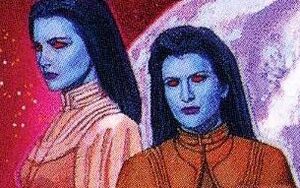
The Chiss were a near-Human species distinguished by their blue skin and glowing red eyes, which grew darker depending on the oxygen content of their surroundings. The more oxygen present, the more intense the color of their eyes and skin tone. While their hair was typically jet black, it did on rare occasions go gray with age (most Chiss believed that the development of gray hair was an indication of the siring of exceptional children).[6] Their physical form led to some speculation on whether they were an offshoot of humanity's ancient expansions into the galaxy or whether their physical form coincidentally matched that of Humans.[5] However, genetic analysis indicated that they were an offshoot of humanity, and it was believed that moving underground led to a divergence between them and baseline Humans. Furthermore, this analysis indicated that their unique skin tone was the result of exposure to glacial minerals.[7] Their blue skin, jet black hair and red eyes generally commanded attention once they were in a crowd of regular humanoids, and these features made them physically striking and instantly recognizable.[8]. Male and female Chiss tend to be more powerfully built when compared to Humans but exhibit the same variances as Humanoid sexes. A fully grown Chiss typically stood between 1.6 to 2.1 meters in height.[6] Around 36 years after the Battle of Yavin,[9] an average adult Chiss stood at 1.7 meters,[4] and in the next century that increased to an average of 1.85 meters for males and 1.7 meters for females by 130 ABY.[2]
The University of Sanbra concluded that the fact that all Chiss often appeared in very good physical shape was an indication that the species possessed an active metabolism which was responsible for their trim figure and lower body temperature. Thus, this was believed to be responsible for preventing obesity that was commonly found within more sedentary humanoids. While the report concluded that they were indeed near-Humans, they had not determined a specific point of evolutionary divergence.[10] There was, in fact, a Human sleeper ship colony established on Csilla around 27,500 BBY, though records of this were virtually nonexistent and it remained unknown how a remote area of the galaxy could have been trailblazed so far back.[1] They did display, physiologically, very few signs of evolutionary adaptations to their icy environment with even their skin pigmentation not providing any apparent benefit. Beyond the obvious physical features, physiologically, the Chiss were similar to Humans to the point that they possessed a comparable circulatory, neurological, digestive and reproductive systems.[10] The Chiss vocal mechanism was noted for being similar to Humans but there were apparent differences which was evident in their capacity to speak their native language.[5]
In addition, they experienced a greatly accelerated growth rate compared to Humans, which contributed to their reaching maturity faster than Humans. Thus a Chiss at the age of 10-years held the physical maturity of a 20-year old Human. This in turn resulted in a culturally-imprinted emotional maturity that was many times above that of their Human counterparts.[10] They were capable of living up to 80 years old, at which point a Chiss was considered venerable; children were between ages 1-10, and they experienced a rapid growth spurt by which they were considered full adults. Middle-age followed between the ages of 51-62, and those aged 63-79 were considered old.[6][11]
Certain anthropologists believed that the Nagai were perhaps an offshoot of the Chiss but no legends or history records in either species indicated the validity of such a claim.[1]
History
Beginnings
The origins of the Chiss were largely unknown, even to the Chiss themselves, though some scientists thought that they were the result of a long forgotten Human colony that had been lost to time.[2] This was the leading theory held by not only Chiss historians but scientists within the New Republic who held the view that this colony predated the formation of the Old Republic.[6] A report by the University of Sanbra indicated that very little was known of Chiss history due to their own records being carefully guarded on their homeworld. However, scattered reports from many intrepid scholars suggested the Chiss were a forgotten colonization attempt; this theory was mostly based on their resemblance to Humanity.[10] Genetic analysis later confirmed that the Chiss were indeed an offshoot of the Human species' earliest attempts at colonization. It was believed that sometime before 27,000 BBY, a lost colony of Humans settled in the Unknown Regions on the planet Csilla.[7]
According to Chiss legend, their homeworld was once a warm and tropical planet.[6] However, the planet was later locked in an ice age with profound glaciation encompassing the terrestrial world. This forced the Chiss ancestors to travel along the ice front's leading edge in order to survive at the temperate front as glaciers began spreading across the planet. Though it was believed that the glaciation process occurred over an extended period of time, it was also at an age when the Chiss were already technologically advanced which allowed them to overcome these challenges to their survival by way of technological adaptations.[10] This led many to conclude that the early Chiss existed on Csilla prior to it succumbing to an ice age.[6] Thus, Csilla nearly became inhospitable by 5000 BBY, and it was only by living underground that this divergent species survived. These events furthered the genetic changes notably seen in their skin tone and eyes.[7] Thus it was believed that by going underground, the race gradually began to diverge from the baseline Human species, the glacial mineral content beginning to alter their physiology into its more modern form.[6]
Xenosociologists believed that this period had a profound mental impact on the developing Chiss and led to the evolution to their current mindset. However, little was known of these early Chiss as certain legends indicated that a decadent culture had formed in the tropics that were unprepared for this ice age. Related parables even stated that northern dwelling Chiss slaughtered their decadent southern cousins when resources became sparse and chilling temperatures befell the planet. Regardless, it was known that the Chiss adapted well to their planet during its climatic change and began tapping into geothermal energy as a power source. This led to the building of several populous cities amongst the glaciers and were quick to develop a global government. Thus, they avoided the adolescence period common to developing worlds that saw nations compete with one another, along with adopting a planet-wide tongue. Eventually, their species mastered star travel independently with some speculation that they tapped into the ancient memories of the colonization effort that first brought them to Csilla.[10]
The Ascendancy
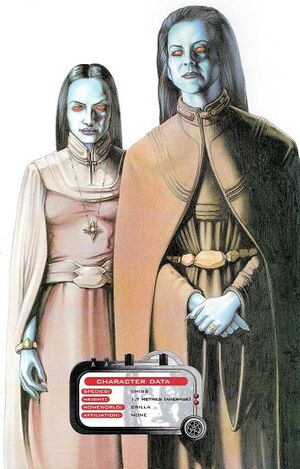
- "The galaxy outside Chiss territory is not a very safe place to be."
- ―Aristocra Chaf'orm'bintrano
The initial Chiss star-travel era involved their scientists attempting to create hyperfields over vehicles designed to carry passengers. At the same time, automated drones were launched into the Unknown Regions with specialized beacons that led to the creation of a network of navigational anchor-points.[10] As the Chiss began to expand into space, a Syndic by the name of Jer'Jo Cam'Co was responsible for the formation of the Chiss Expansionary Defense Force. He proposed the creation of this group after explorations efforts yielded several resource rich worlds.[13] Much of their expansion was governed by the need to gather resources without upsetting their homeworld's ecosystem. Though their territory later managed to suffice for their growing population, the Chiss continued to expand into space. However, this was not out of exploration of the unknown or out of greed but a leading theory indicated that they sought to impose order over a chaotic region of space.[10] The government on Csilla controlled 28 major colony worlds scattered across Chiss space, united in a political federation known as the Chiss Ascendancy. This species remained a complete mystery to most of the galaxy and were completely removed from the various galactic governments. Thus, over the course of thousands of years, the Chiss began to develop socially and technologically in isolation.[14]
Though the Chiss were not widely known to the greater galaxy, examples of their technology were known to exist as far back as 3951 BBY when samples of their charric weapons were being sold on the planet Onderon.[15] When the Sith Empire returned to fight the Republic once more during the Great Galactic War and the Cold War, the Chiss Ascendancy was the only formal ally of the Empire. Essentially rendered a vassal state by diplomatic treaty, the Chiss would provide military assets and resources to the Empire in exchange for governing autonomy. In doing so, the Chiss were able to escape complete subjugation under the imperials, a common fate for many alien species.[14] During this time, some Chiss were known to serve as Imperial Agents[16] or bounty hunters. A few rare Chiss even achieved official rank in the Imperial military. In this time, Chiss agents were sent on loan to the Imperial Military forces on Hoth where they aided the Ministry of Logistics by providing cold weather training and equipment for skirmishes on the icy world. In addition, the Chiss established a secret outpost on the planet known as Zero Station where Aristocra Saganu of House Miurani oversaw his peoples efforts in aiding their Sith allies against the Republic.[14]
Around 1000 BBY, the forces of Lord Kaan's Brotherhood of Darkness encountered the Chiss in the Unknown Regions and managed to bring a legion of them to the planet Thule. The Chiss that were born there spread into the wider galaxy although they were still relatively unknown to many.[7] It was known that the law against pre-emptive strikes and aggression had been in place for a thousand years.[12] Between 1000 BBY and 990 BBY, a Chiss by the name of Cyndra was known to have operated in the wider galaxy where she was a member of the Anti-Republic Liberation Front.[17]
The rise of Thrawn
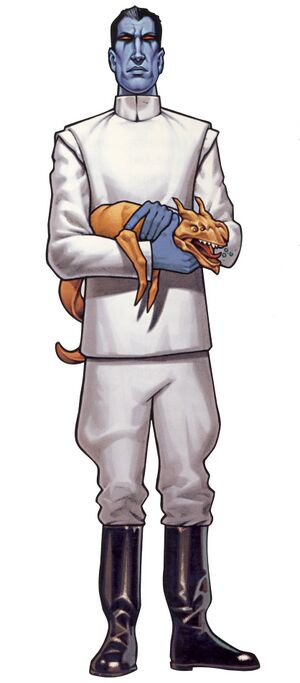
- "Grand Admiral Thrawn's actions paint us in a dubious light. I understand the reluctance of many people to deal with us."
- ―Jagged Fel to Jedi Master Luke Skywalker
In response to the threat of invasion, a vast interstellar fortress began to be prepared in the Redoubt Cluster in 28 BBY with the pace of the project growing in urgency as a safe haven for their people if they were ever invaded. This was prior to any renewed contact with the Republic.[12] In this era arose a young officer in the Expansionary Fleet known as Thrawn who began to press for the abandonment of the hallowed doctrine that outlawed preemptive strikes. He believed that the Chiss could not place themselves in a situation where they were forced to fight against the Vagaari and the Yuuzhan Vong (in the original) simultaneously, but while others like Admiral Ar'alani and his brother Syndic Thrass acknowledged the danger, they viewed his enthusiasm for combat and aggressive scouting with some concern.[5]
In 27 BBY, Thrawn's patrol encountered Corellian traders - the crew of the smuggler ship Bargain Hunter—marking what seems to had been the first modern contact between the Ascendancy and the Old Republic. Although initially suspicious of these outsiders, Thrawn decided that they were no threat, and he came to regard two of them, Jorj Car'das and Maris Ferasi, as friends.[5]
Far more dangerous incursions from the Republic followed within a few months. Outbound Flight, a massive exploration mission consisting of six Dreadnaught Cruisers led by Jedi Master Jorus C'baoth, had unwittingly scheduled a sublight flythrough of a system on the edge of Chiss space, and it was here that a powerful Trade Federation battlegroup stationed itself in order to intercept and destroy them, led by Kinman Doriana, a personal agent of Darth Sidious. Thrawn, investigating the Trade Federation ships and despite being hopelessly outgunned on paper, defeated them through superior tactics. Leaving the command ship intact in a move to secure face-to-face communication, Thrawn boarded the Trade Federation Battleship, which led to a meeting with Doriana—and a HoloNet discussion with Sidious, himself—who persuaded Thrawn that the Jedi expedition could not be allowed to blunder into the Yuuzhan Vong. Although none at the time would know it, Thrawn's highly favorable first impression made on Palpatine would ultimately change the galaxy and its perception of the Chiss people forever.[5]
Thrawn engineered a clash between the Vagaari and Outbound Flight, weakening both sides to the point at which his small patrol force could effectively end both threats, but the resulting battle did not unfold according to his plan: while C'baoth was attempting to kill Thrawn using the Force, a remnant of the Vagaari force was able to flee to hyperspace, and a series of Chiss radiation bombs designed for the Vagaari command craft were unintentionally detonated aboard the Dreadnaughts. This killed the Jedi Master before he could kill Thrawn; and the damage to the Republic expedition was disastrous. Of the fifty thousand personnel aboard Outbound Flight, only fifty-seven survived. The aftermath of Outbound Flight also revealed tensions within the Chiss power structure, as Aristocra Chaf'orm'bintrano tried to claim Outbound Flight for the Fifth Ruling Family.[5]
This was not the only impact the Chiss had on the galaxy as in 22 BBY, a female Chiss by the name of Sev'rance Tann left her people and joined Count Dooku as one of his Dark Acolytes during the Separatist Crisis and led a Droid Army in the Clone Wars as well .[19] Her lover, Vandalor, also served as a bounty hunter during the conflict.[20][21] During the war, a diplomatic effort was launched by the Galactic Republic under the direction of Supreme Chancellor Palpatine to make contact with the Chiss Ascendancy. This saw Aristocra Sev'eere'nuruodo being dispatched to Defense Force Station Ifpe'a where they awaited the Republic delegation consisting of Chiss Jedi Padawan Nuru Kungurama and the clone troopers of Breakout Squad. The Aristocra, however, conveyed the message that the Chiss were staying neutral in the conflict at which point the station came under attack from Separatist forces led by a Skakoan known as Umbrag. This saw the Aristocra taken away to safety whilst the Chiss forces battled the CIS fleet and afterwards she was returned back to Chiss Space.[22]
The Household Phalanx
- "We are Syndic Mitth'raw'nuruodo's Household Phalanx. We live only to serve him. And through him, serve the Chiss."
- ―Kres'ten'tarthi to Mara Jade
Thrawn continued to persist in his challenges to the first-strike doctrine of the Ascendancy in the belief that it made his people weak.[7] This approach did lead to a disagreement with the Chiss ruling houses who did not approve of a pre-emptive strike against an unconfirmed enemy.[24] It was this approach and similar such actions that put Thrawn at odds with the ruling families.[7] Ultimately, they decided to brand him a renegade[24] and banished him to a primitive[7] jungle world on the fringes of known Chiss space.[24] In 19 BBY, he was discovered and recruited by the Empire. For almost three decades, however, his true capabilities, and his true status within the Imperial hierarchy, were kept carefully hidden even within the ranks of the military. Despite being exiled and rejected by his people, Thrawn was known to have remained very protective of his kind. This was evident by the fact that he never revealed the whereabouts of the Chiss to outsiders.[4] After rising to the rank of Grand Admiral, Thrawn was seemingly exiled from the Imperial court for a breach in the practices of the Imperial Palace. In truth, this was actually a cover story orchestrated by Emperor Palpatine in order to explain the departure of his greatest tactician.[12] Thrawn afterwards began an Imperial campaign of subjugation of the Unknown Regions in the name of the Galactic Empire[7] with this secondary duty seeing him disappearing for long periods at a time.[24]
Sent with a task force into the Unknown Regions, this group was given the secret mission of exploring the area and conquering new systems for future Imperial expansion.[12] Whilst mapping large portions of space, Thrawn re-established contact with his comrades within Chiss territory. By this time, the Chiss had been battling the many dark threats that surrounded them and saw hope in Thrawn's manner of leadership. As a result, many Chiss ended up flocking to his banner in order to preserve their way of life.[24] Within a few short years, Thrawn had opened up large expanses of territory and placed them under the command of his Imperial forces as well as those handful of Chiss that remained loyal to him. In addition, the intense secrecy of the project meant that few outside of Palpatine and those assigned to Thrawn's forces were aware of their existence.[12] With his fleet of Imperial Star Destroyers, the Imperial forces were known to have worked alongside the native forces of Thrawn's own Household Phalanx. The territory conquered in these campaigns quickly became the basis of a new power that became known as the Empire of the Hand. This new government formed a stand-off relationship with the Chiss Ascendancy with an uneasy relationship between the two sides. Though considered a renegade by his people, many Aristocras secretly supported Thrawn's actions as they believed his proactive stance ultimately kept the Chiss people safe.[7]
Whilst largely unknown, there were Chiss involved in other events in the galaxy. Notable instances included Droma Ordo and the trader Tyrral who resided at Station Gamma in 1 ABY. During the Galactic Civil War, one Chiss who had joined the Alliance to Restore the Republic, known as Captain Voldez, participated in the Battle of Restuss. Another Chiss by the name of Laen Pieweto led a group of poachers during hunts at the Rodian Hunting Grounds on the planet Kashyyyk.[25]
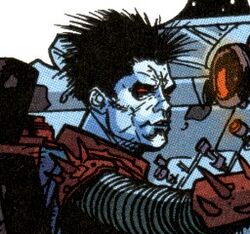
There were no other recorded encounters of the Chiss although they were known to have fought against the Ssi-ruuvi, a potent reptilian species who were a military threat as fearsome as the Nagai and the Yevetha.[4] This event occurred a few months after the Battle of Endor when a preemptive strike carried out by Thrawn's Empire of the Hand attacked the Ssi-ruuvi Imperium.[1] This initial clash allowed the CEDF to directly intervene and invade Ssi-ruuvi territory in response to their attacks on Ascendancy colonies. The short resulting war between the two powers left the Ssi-ruuk crippled with the victorious Chiss becoming the ultimate power within the Unknown Regions.[7][6]
In 9 ABY, Thrawn left the Unknown Regions to take supreme command of the Empire's war machine, and launched his campaign against the New Republic. In spite of his death at Bilbringi, his legacy endured, not least in the form of the House Phalanx and their allies in what became known as the Empire of the Hand. After Thrawn's death, the New Republic managed to successfully capture a number of logs from surrendered Imperial vessels which provided a few points of interest on the otherwise mysterious Chiss. Among these records included a log by Emperor Palpatine himself on his first encounter with Thrawn.[4]
Thrawn's Empire
- "You joined Thrawn, Fel! That's not the same as joining the Chiss. We have ways and traditions he turned his back on, and by joining him you proved that you don't respect them, either."
- ―Ina'ganet'nuruodo to Soontir Fel
The secrecy of Thrawn's project served it well, and, by 19 ABY, the Empire of the Hand controlled a vast region of space whilst being completely unknown to the Imperial Remnant that was based at nearby Bastion within the Rim frontier.[12] It was the result of the events that led to the Caamas Document Crisis that led to the Jedi Master Luke Skywalker learning of the existence of the Chiss, the Empire of the Hand being based on the largely uninhabited world of Nirauan where the fortress structure known as the Hand of Thrawn served as their official base of operations. At this time, the Empire of the Hand also recruited General Baron Soontir Fel who served in the higher echelons of the Empire of the Hand's government. Chiss paranoia was such that even in the Remnant's highest echelons, his mission and location were apparently largely unknown, and the Baron's sons, Davin and Jag, were required to enroll as cadets to a Chiss military academy, primarily as a hostage to ensure their father's integrity. Following the discovery of the Empire of the Hand, Supreme Commander Gilad Pellaeon with his trusted advisers became aware of them and maintained limited contact with Admiral Parck's Nirauan offshoot regime. In addition, Leia Organa Solo along with the top officials of the New Republic were also aware of the existence of the Chiss and the Empire of the Hand, though they did not know the true extent of the territory of the latter, which was kept a secret by Jedi Master Luke Skywalker and Mara Jade. Similarly, the Chiss knew virtually nothing of the New Republic or its worlds while maintaining the policy that Thrawn was a renegade that brought dishonor to the rest of his people. This era would also see their haven in the Redoubt Cluster nearing completion.[12]
Society
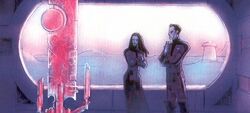
Even in the era of the Galactic Alliance, the wider galaxy seems to have had no direct contact with Chiss civilians. What was known about them was, as mentioned above, mediated largely through encounter with military units, and through a few high-level contacts with political and diplomatic delegations. It is perhaps no surprise, then, that the military and the ruling class were the best understood aspects of Chiss society; or at least, the best documented.
The Ruling Families
The best-documented means of acquiring Family status through merit was that which was attained in the military. For the duration of their service, every officer in the Chiss military was attached to one of the Ruling Families as a "merit adoptive," and while under normal circumstances, this Family status was lost when an individual left the service, those of particular ability were said to be "born to trial," and given the opportunity to make their Family status permanent. If these Trial-born of the Family were successful, they would be permanently "matched" to the lineage. Conversely, members of a Ruling Family could apparently also be "released" and "rematched," although it is even less clear how this processes operated.[5] It is possible that marriage was involved in matching, although no mention is yet known that indicates an institution of marriage among the Chiss. A hierarchy of leadership within each Family consisted of brothers and sisters (known collectively as siblings), plus cousins, and ranking distant relations—the last being the highest level that the most able Trial-born could reasonably hope to achieve. Individuals with the ranks of Aristocra and Syndic also served as high-level representatives of the Families, with seemingly plenipotentiary powers, though an Aristocra could hold only collateral rank within the internal hierarchy, and a Syndic at least could be Trial-born.
Government structure

The heart of Chiss politics and government was on their homeworld of Csilla where the ruling families met the House Palace at Csaplar. It was there that both the Cabinet and Parliament resided. Representatives of the 28 colony worlds were located at Parliament where they were appointed as governors or House leaders. The Cabinet handled the intricacies of governing with all their decisions being approved by one of the four families. Chiss governmental structure existed to move important decisions up the chain of command and ultimately to the ruling families themselves. As such, individual colonies had their voices heard in the Parliament with these being taken up by the departments of the Cabinet after which they were finally given to the families. The positions in Parliament were democratically chosen by colonial vote which differed compared to Cabinet who were all appointed by the families.[10]
Their government was highly structured and ordered with the rule of law being enforced by the ruling families. These were not biological family groupings but instead different branches of their government.[11] The Csapla dictated colonial issues, natural resources and agriculture whilst the Nuruoda handled the military as well as foreign affairs. Inrokini were responsible for industry, science, communication and non-military technology with the Sabosen taking the duty of overseeing justice, public health as well as education. All "four" families along with the average Chiss citizen were represented at Parliament.[6] Though not led by a dictator, the Chiss believed that only rigid discipline and superior technology were needed to hold the forces of anarchy at bay.[7] The ruling class were known to engage in constant power struggles but despite this fact, the Ascendancy maintained strict controls over its territory which led to its civilization to prosper.[14]
One established body within the government structure was the Council of Families that was responsible for aspects of policy and strategy thus allowing them to shape as well as direct Chiss society across Ascendancy. It was known that the Council was capable of objecting in cases where a Ruling Family was conducting actions to upset the delicate power balance such as by forcibly taking advanced alien technology to provide their forces with an advantage over the others. However, this procedure was noted for being a long and complex one which was largely ineffective in practical considerations. Arisctocra's were also known to be capable of meeting with the Council in order to petition for the safe return of outsiders that were trapped within Chiss Space.[5]
Military forces
- "He has his orders, and when a Chiss accepts orders he carries them out, period."
- ―Chak Fel on Drask
The Chiss were noted for being a serious and disciplined race that managed to create an impressive military force as well as forge a large star-spanning empire.[24]Their military was known as the Chiss Expansionary Defense Force[7] which was also known as the CEDF, the Chiss Expansionary Fleet and the Chiss Defense Fleet.[5] Whilst their kind were methodical as well as cautious; they were always prepared to respond with lethal force if their enemy made the mistake of firing first. Through the CEDF, they patrolled the Unknown Regions and monitored any threat with their fleet of top-of-the-line capital ships as well as squadrons of clawcraft starfighters. In many similar respects to the Galactic Empire, the Chiss military was well armed and trained military force that encompassed several advanced as well as orderly worlds.[7] It was known that they maintained an impressive fleet which was dedicated to the defense of their territory. In fact, their military was a sizeable force with the Nuruodo family being in charge of both the fleet and the army. As they had never needed to act as a single unit, the military was partitioned into 28 colonial units known as Phalanxes. Their operation usually fell upon the shoulders of an officer appointed by a House leader who were known as Syndics. The Phalanxes were a completely separate entity from the Chiss Expansionary Defense Fleet which was deemed a foreign affairs asset rather than a military one.[10] Members of the Chiss Defense Fleet wore the color black as it was a combination of all colors which symbolized the fact that it drew its personnel from all the families. Even honor guard details of warriors wore military black instead of their house colors.[12]
It was known that anyone that was caught hiding illegal substances or supplying cargo to their enemies were likely to have their goods confiscated.[7] The CEDF patrolled their growing territory and observed neighboring worlds.[10] Furthermore, anyone that violated Chiss Ascendancy space were to be intercepted by the Household and Colonial Phalanxes who zealously guarded their territory. These served as a homeguard unit that protected the 28 colony worlds as well as the planets of the ruling families. As such, it was virtually impossible to infiltrate Chiss Space: any intruders caught were often kept at a penal colony to suffer a prison sentence at an outlying system.[7] Whilst the CEDF patrolled the borders of Chiss space, the Phalanxes responded to any threats that got past the Fleet. In times of crisis, however, the CEDF supplemented its numbers by drawing upon the ranks of nearby Colonial Phalanxes.[10]
A significant portion of the CEDF which mostly consisted of Mitth'raw'nuruodo's Household Phalanx took an extended leave of absence from the military. This was in order for them to deal with encroaching threats to the Chiss Ascendancy. Though this could be construed as secession or even treason, the ruling families took no part in inciting inflammatory action against this group. Thrawn's Phalanx, in the mean time, was known to had worked in conjunction with a cell of Imperials in order to conduct a more proactive campaign of guarding Chiss territory. This was done so in a manner that was not comfortable to the Chiss which the ruling families pretended to be oblivious of though the average citizen were well aware of these activities.[10]
It was known that senior officers of the Defense Fleet belonged to no Chiss family and were in fact stripped of both family name as well as privilege. This was because they were made formally part of the Defense Hierarchy so that they could be called upon to serve all Chiss without deference or prejudice. Thus, ultimately, military command was merit-based and did not involve any family connections. Once taken into the Hierarchy, the officers were required to prove themselves in a similar manner as how the Ruling Families selected merit adoptives. In fact, all warriors were made merit adoptives when they were accepted either into the Defense Fleet or the Expansionary Fleet. Admirals of the Defense Hierarchy took direct command of Defense Fleet battlegroups, and also held oversight over the Expansionary Fleet. The mandate of the Expansionary Fleet, in contrast, was defined as guarding the Chiss frontier and exploring unknown space beyond the edge of the Ascendancy, and its forces included Picket Forces commanded by officers known as Force Commanders (sometimes shortened to Commander; Crahsystor in Cheunh). The best-known of these frontier units is Picket Force Two, which in 27 BBY apparently consisted of three light cruisers, each with three fighter escorts, plus a further five fighters and two transport shuttles at their asteroid base in the Crustai system.[5]
Adding to the confusion is a variety of evidence for other Chiss military forces operating alongside, and sometimes in opposition to, the black-uniformed personnel of the Expansionary Fleet and the Defense Fleet. Thrawn's Household Phalanx has already been mentioned, and in 27 BBY, the Chaf family were also observed to deploy military forces of their own, capable of deploying nine light cruisers at short notice, in an effort to overwhelm an Expansionary Fleet picket force.[5] Just as some of Thrawn's warriors wore the burgundy colors of the Ruling Family to which Thrawn belonged, many Chaf Family personnel were observed at this time wearing uniforms in the yellow of the Family they served.[12]
There were thus potentially as many as five distinct military organizations within Chiss society:
- Defense Fleet—defensive fleet units under the authority of a central high command.
- Expansionary Fleet—frontier patrols and exploration missions.
- Colonial Phalanxes—planetary militias guarding the Chiss colony worlds.
- Household Phalanxes—paramilitary guards loyal to the aristocratic Ruling Families.
- Chiss warriors fighting for the Empire of the Hand—including Thrawn's rogue House Phalanx and possibly also other Chiss personnel among the "forces of the Empire".
Additional to all this, of course, were the forces of Thrawn's rogue Household Phalanx: in 19 ABY they could deploy at least a hundred Blastboat-sized TIE scouts, and in 26 ABY they deployed a wing of 36 Clawcraft at Garqi and Ithor. By the time of the Swarm War in 36 ABY, the CEDF could deploy a powerful fleet of thirty Chiss Star Destroyers in the Battle of Tenupe, with each Star Destroyer massing more tonnage than an entire Picket Force of sixty years earlier.
Chiss considered themselves to be among the finest and most capable of warriors.[5] One of the institutions where their military trained was known as the Chiss Academy that gave tasks to its students with high marks awarded depending on the degree of success achieved in the mission.[19] Their cold disciplined nature made them brilliant strategists and excellent tacticians.[8] Much of the ranking structure of the Chiss paralleled that of the larger galaxy with numerous titles that included:
- Syndic : senior officers that held the position of Syndic were at times appointed by House leaders to take charge of a Colonial Phalanx.
- Assistant Syndic : a seemingly senior post within the CEDF and was held by ex-Imperial Baron, Soontir Fel who held the post of Assistant Syndic.
- Admiral : consisted of senior officers of the Defense Hierarchy.
- Captain : ranking officers onboard naval ships.
- Commander : a common position that denoted officers in charge of many elements that ranged from cadet squadrons, frontier patrols, space station command and even to a major fleet unit.
- Lieutenant : this included personnel in cadet units and were junior officers.
Clothing
The House Phalanx Commanders that were stationed at the Hand of Thrawn were seen wearing burgundy uniforms.[23]
Language and names
- "I can teach you to understand Cheunh. But I doubt you'll ever be able to properly speak it. I've noticed you don't even pronounce my name very well."
- ―Thrawn to Car'das
The Chiss language was Cheunh and was first accepted during the developing years of their civilization when they formed a planet-wide government which consisted of a single tongue that their society accepted. It was known to be a dense and difficult synthetic language to master as complicated ideas were expressed by uniting unrelated words into larger words. Thus, it had relatively few core words though the syntax required the speaker to piece together compound words which was complex and involved. One factor that certainly added to the complexity of the language was the fact that written Cheunh was not set down in a phonetic alphabet. In writing, Cheunh did not possess an abstract alphabet like Aurebesh with ideograms representing concepts and complex ideas being expressed by combining simpler ideograms. The Chiss held great pride in not only understanding but conversing in such a convoluted language.[10] It was hard for outsiders to understand though Car'das believed it to be a logical, and the Chiss believed that the grammar was logical and easy to learn. However, the Chiss believed it was quite impossible for non-Chiss to learn to speak it properly.[5] Though this complex, nuance-filled language was difficult for non-Chiss to master due to its intricacies, the Chiss themselves had little trouble mastering Basic though many were unfamiliar with it.[2] At least some phrases in the language were highly idiomatic – the pejorative moactan teel literally meant "fair-haired", implying that something about the addressee was non-Chiss, and thus barbarous.
Traditionally, Chiss names consisted of a long tripartite structure with three distinct sections.[2] Usually, this followed the convention of the first and last being family names and the middle being the given name. Abbreviated versions of these were known as core names with their usage being a questionable choice. This was because full names were required for formal occasions, strangers and those that were believed to be the speaker's social inferior. However, this policy was capable of being broken if there were good and valid reasons for doing so. Such was the case when dealing with outsiders who had trouble pronouncing Chiss full names.[5] The predominance of core names, at least in communication with outsiders, was such that a number of such names were recorded without the full name being known, such as Prakk, Kayree, Lev, Szardra, Voss and Zilvad.[11] Apparently, the core name was typically formed by combining the short central section of the name with the last sound of the preceding section and the opening sound of the following. For example, Mitth'raw'nuruodo was Thrawn, Kres'ten'tarthi was Stent and Brast'alshi'barku was Talshib. The female officers Hess'irolia'nuruodo (Irolia) and Ina'ganet'nuruodo (Ganet) appear to be exceptions to this rule.[source?]
The Chaf diplomats Chaf'orm'bintrano ("Formbi") and Chaf'ees'aklaio ("Feesa") bore the name of the Ruling Family to which they belonged as the first element of their full name, and this also defined the opening sound of their core name. Likewise the brothers Mitth'raw'nuruodo and Mitth'ras'safis were both (adoptive) members of the Eighth Ruling Family, suggesting that this family was known as the Mitth. A similar family relationship is implied between General Prard'ras'kleoni ("Drask") and Station Commander Prard'enc'iflar, although it is not known whether "Prard" is one of the Nine Ruling Families.
Senior Chiss military personnel surrendered Family status on assuming high command. Admiral Ar'alani of the Defense Hierarchy and possibly Sev'rance Tann of the CIS seem to have eliminated their Family designation from their names. The Fel Empire and later Krayt Empire Moff Fehlaaur'aitel'loro was consistently addressed by his fellow Moffs as Fehlaaur, the section usually reserved for the family name. Another Chiss with an anomalous name was the important historical figure Jer'Jo Cam'Co, a Syndic and one of the founders of the Ascendancy.
Culture

Galactic perceptions of Chiss behavior was, following the Battle of Endor, much based on the personality of Grand Admiral Thrawn. However, following that period, it became apparent that Thrawn himself was an exceptional member of his kind with all Chiss demonstrating individually different traits. The impression held by the galaxy was that the Chiss were arrogant, aloof and calculating beings. However, while this was true in some cases, the Chiss demonstrated varying personality types similar to other species. General traits demonstrated by them, however, were being well-educated, artistic and cautious when dealing with outsiders.[2] Outsiders had the general impression that the Chiss were a very polite and highly civilized species.[5] Their reputation meant that they were both respected and, in some cases, feared.[8]
The harsh cold conditions of Csilla led to the Chiss developing a self-reliant streak which was the core of their notoriously aloof personalities. This led to outsiders characterizing their race being as cold as the ice plains of their homeworld.[7] As a people, they were intelligent as well as highly valuing of their privacy. This extreme protection of their society was what allowed them to remain hidden from the rest of the galaxy for so long. They were described as being pensive as well as contemplative, deliberate and calculating. This meant that they often studied situations from many different viewpoints. As such, they considered all alternatives to a situation and even considered scenarios of what would have happened if they had made different decisions. In combat situations, Chiss acted both calmly and intelligently as well as formed well planned strategies.[4] Chiss did not give themselves over to passion and instead viewed problems as curiosities that needed to be solved through rigorous application of brainpower. As such, they did not allow hot emotions to interfere with their methodical analysis of a problem through logic.[7] In terms of personality, they often displayed a cold, arrogant and disciplined behavior.[11] Though they showed a cold lack of emotion, their actions were not necessarily impartial as most were motivated by the pursuit of power which was encouraged by their ruling families.[7]
In general, they lived a harsh but disciplined life style where self control along with propriety were the most valued character traits that all Chiss aspired to. While passions themselves were recognized, they were done so with disdain as such energy was believed to be better applied elsewhere. The regimented style of their society meant that crime was abhorred and seen as the weakness of an individual. Blaming society was a notion completely alien to their mindset and justice was given with little thought on compassion. However, the Chiss did not believe in capital punishment as they recognized it as being an irrational, emotionally driven reaction instead of being a true deterrent. Instead, the greatest punishment they gave for their most heinous of crime was exile. Due to the great importance of family loyalty existing in their culture, exile was considered a grave punishment for any Chiss to face.[10]
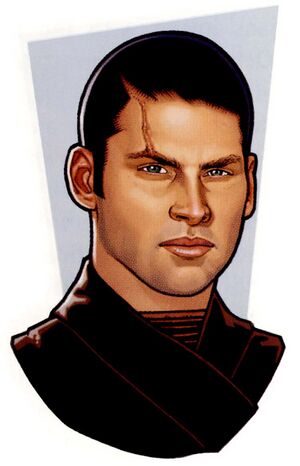
During their childhood, Chiss were taught to read through the great stacks of data of the great library on Csilla. These contained basic information that every Chiss absorbed during their childhood after years of intense schooling.[7] Scientists believed that they essentially bypassed the adolescent stage and reached maturity quickly.[4]
Their society was highly structured and ordered with the rule of law being enforced by the ruling families. These were not biological family groupings but instead different branches of their government.[11] The Csapla dictated colonial issues, natural resources and agriculture whilst the Nuruoda handled the military as well as foreign affairs. Inrokini were responsible for industry, science, communication and non-military technology with the Sabosen taking the duty of overseeing justice, public health as well as education.[6] These ruling families were composed of clans that were headed by government officials known as Aristocras. Those Chiss that belonged to the same house defended one another at every opportunity whilst those from competing houses searched for facts that could be used to snipe or undermine the other whilst attempting to secure any advantage for themselves. Though Thrawn was an exceptional member of his species, his rational approach to problem solving was shared by the ruling families that governed the Chiss Ascendancy.[7]
As a general rule, Chiss did not take part in any action that would bring shame on their house with entire family lines exiled due to the actions of a single member.[2] The ruling families themselves were quite aware of any opportunity where they were able to exploit the weakness of a rival. As such, they were quick to take offense at any insult that was perceived against their position. Those Chiss caught in the middle of inter-house rivalries spent much of their time in intelligence gathering in order to get useful information that could be used for blackmail even if it was only capable of being used many years in the future. This trait made the Chiss excellent counterintelligence agents with a trained member of their kind able to see through disguises, evaluate body language, detect idiosyncrasies in speech pattern and even distinguish authentic items from forgeries.[7]
The long spacefaring history of the Chiss led to the creation of a superior combat force with their starfighter pilots being infamous throughout the Unknown Regions. Such squadrons were ruled by discipline and their pilots were known to spare disabled starships if they broadcasted a surrender.[7] They were highly committed in their duties and a Chiss warrior, if given an order, would carry it out even if they disagreed with it, which highlighted their belief in the chain of command.[12] It was also known that the Chiss as a culture had an aversion to suicide and expendability as they found those actions to be wasteful.[26]
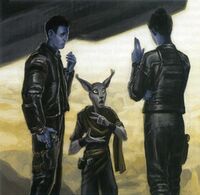
The Chiss had a keen interest in art and science and were skilled in mathematics. Their thought processes were based around a logical mindset, being interested in philosophy and in learning about other cultures. On the other hand, they were also xenophobic, and any knowledge gained from other cultures was used as a means of gaining an advantage over a potential foe.[2]
Their clinical detachment was similar to how a biologist studied an insect which was how the Chiss view their foes and they often engaged in extreme caution in such circumstances. When among non-Chiss, individual members of the race were often aloof and pensive as they plotted tactics which would ensure a victory if a confrontation were to occur. Chiss never truly lost their xenophobic instincts, even when they were among members of other species for long periods of time.[11] Ultimately, Chiss were loyal to their own kind and looked down upon aliens as being barbaric as well as immature.[10] Despite this fact, most Chiss were considered peaceful and did abide by the strict code of conduct that governed their race.[2] In addition, though xenophobic, they were at times willing to accept members of other races into their ranks so long as they proved to be exceptional as well as trustworthy individuals.[13] Furthermore, the subject needed to prove themselves capable of following Chiss disciplines in order to gain their loyalty and respect.[10]
When attacked, they responded with calm, intelligent and well-planned strategies while at the same time remaining an honorable species.[4] They never made conflicts personal and were very rarely aggressors as they prefer to let conflicts come to them.[10] Among the most famous traits of their kind was their refusal to invade the territories of other species or even wage war over potential foes. As such, they did not believe in the concept of a preemptive strike against their foes. Rather, they only responded to an enemy assault after their foes had struck first.[5] This was actually a by-product of their cool and cautious philosophy. This was because, in their view, that by allowing their enemy to draw first blood they guaranteed that that they were acting in the right. Furthermore, it divorced their actions from any recklessness which resulted from either impulsive anger or the incomplete intelligence of an enemy's intentions.[7] Striking first was thus an anathema to their discipline with even tactically sound preemptive strikes being the subject of controversy.[10] This moral imperative was so pervasive in their culture that they exiled Thrawn from their society for breaching it.[4]
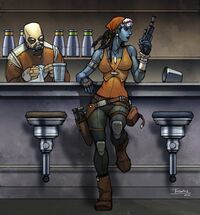
The Chiss society had no concept of finances or money with everything being provided for by the state. They also maintained tightly controlled borders that were self-sufficient in the isolated territory that they rule. Their colonies supplied them with both food and resources while developing technology comparable to the rest of the galaxy. As such, they saw no need for trade and their culturally derived contempt of "lesser races" also prohibited them from forming better relations with their neighbors. In fact, the motive for their exploration and expansion was difficult to determine as they lacked the passion for conquering the unknown which was a trait that Humans possessed. In addition, they did not claim new territory out of greed or for a hunger for power. Their space program was mostly governed by the basic need to manage their population and gathering resources without upsetting their homeworld's ecosystem. Their territory sufficed for their entire population needs. A report by the University of Sanbra indicated that the Chiss population numbered nearly 5 trillion. Despite their growing border, they still fostered a cultural contempt for other species. Instead, they believed in isolation and the preservation of their heritage.[10]
It was believed by many xenosociologists that the rigid and disciplined nature of Chiss society stemmed from their cold environment on their homeworld. They were noted for displaying no signs of decadent or greedy behavior and thus it was concluded that any signs of colonial expansion were mostly due to the Chiss desiring to put order onto chaotic locations.[11] This was in fact the leading theory by the University of Sanbra who concluded that the motivation for Chiss expansion was their ideal of seeking to impose order on what they saw as a chaotic and barbaric region.[10] Being nearly impossible to enrage, they preferred to only act when all factors had been taken into account with the issue itself analyzed.[7] In addition, they believed firmly in the chain of command as well as positions of authority. In fact, Chiss were taught to respect the position itself rather than the person holding that title. As such, Chiss often responded when an individual called out the rank rather than their name.[18]
Some reports indicated that there were no Chiss Jedi and it was not known whether there was a Force-tradition within Chiss society.[2] However, this did not appear to be the case as there were at least two known Force users amongst the Chiss.[19][22]
Technology
Construction and automation

The Chiss were notable for having developed their technology independently from outside sources though they managed to develop analogs of many standard galactic technologies.[10] A major problem with understanding Chiss technology is distinguishing specifically Chiss elements from its wider context. For instance, the celebrated Nssis-class Clawcraft was a hybrid of Imperial and Chiss technology, and may have also involved the input of other species. These blue-skinned humanoids were well known for their self-control and intelligence that were traits which translated into a series of well designed as well as innovative starships. Travel through hyperspace required Chiss starships to rely upon a number of navigational anchor points that spread out from Csilla. Such a system allowed the Chiss to explore the galaxy methodically though kept them from encountering other cultures. Due to the secrecy involved in Chiss internal politics, outsiders knew very little about individual Chiss manufacturers.[27]
Some Chiss structures were starkly angular, perhaps inspired by the icy geometries of Csilla's glacial landscape. We can note the double-pyramid shape of the Brask Oto space station in the Redoubt, and the angular, faceted hull-design of the ships of the Fifth Ruling Family, such as Chaf Exalted and Chaf Envoy. However, the distinctive design of these ships was highly symbolic, designed to identify them as Chaf Family consular ships and even to identify the specific status and lineage of the Family members they carried. Combat warships of the Expansionary Fleet had far more curved and fluid hull-lines. To outsiders, clawcraft had only been a recent encounter during the era of the Yuuzhan Vong Invasion. At the time, the University of Sanbra only had limited reports of Chiss capital ships due to the fact that none had been seen in action at the time. A report by the University held the view that the Chiss did not possess a ship larger than a 300 meter escort frigate.[10]
Their hyperdrives were not as efficient as the latest models developed by the Corellian Engineering Corporation though they were competent and quite capable of travelling across the distances of their territory. During their star-travel era, they developed the ability to form hyperfields by using precise irradiation of composite materials. However, the early pioneers of this technology were unable to sustain the field around larger vessels that had been designed to carry passengers. Thus, their scientists worked on creating a habitable hyperspace bubble whilst combating field decay though others worked on outfitting automated drones with early hyperdrives with specialized beacons that was responsible for developing the early navigational anchor-points throughout the Unknown Regions. Modern era Chiss craft used the anchor-points for travelling through Chiss Space which was why their vessels lacked navicomputers. This had the effect of preventing the Chiss from safely leaving their borders.[10]
Weapons and defenses
It was known that an initial analysis of Chiss weapons through sensor scans led to an unknown form of offensive weaponry. However, a cursory glance indicated that their fighter craft were equipped with energy weapons, projectile weaponry and an unknown form of missile launcher.[12] As such, it was easier to say that Chiss weapons technology was different from that of the Republic than to compare it qualitatively. For example in place of ion cannon, Chiss warships used missiles that deployed charged Conner net-like weapons called shock nets that could reach up to a kilometer wide, which could disable and trap light freighters, entire formations of starfighters, or even incoming missile salvos.
The Chiss used a unique type of energy weapon, the charric. This weapon fired a lancing blue beam, sometimes described as a maser, which delivered thermal energy comparable to conventional blaster weapons coupled with a much greater kinetic punch, but lacked a stun-setting. Low-power shots instead administered disabling burns. The most common form of charric was a hand-held carbine, but pistols are also known, and larger versions of the weapon were carried by some starfighters, and included among the heavy weapons batteries of capital ships and bases.
In the years before the Clone Wars, it would appear that Chiss beam weapons were limited to charric energy,[5] but by 19 ABY, the Household Phalanx base at the Hand of Thrawn mounted both turbolasers and heavy maser emitters, while both Chiss-style weapons mounts and standard Sienar Fleet Systems blasters were observed on various TIE variants flown by Phalanx pilots.[23]
Known planets and locations
Outside the Ascendancy
- Nirauan—home to a large House Phalanx garrison at the Hand of Thrawn, nominal liaison post between the Imperial Remnant and the Ascendancy, also command post for the Empire of the Hand.
Behind the scenes
The Chiss first appeared in Timothy Zahn's novel Heir to the Empire, in the form of Grand Admiral Thrawn, but the name of his people was not revealed for another eight years, until Zahn's Hand of Thrawn Duology.
Although the basis of the Chiss naming pattern and the distinction between the House Phalanx and the Ascendancy were established in Vision of the Future, these were apparently misunderstood by or imperfectly communicated to some of the authors of the New Jedi Order novels and concurrent sourcebooks. This led to some continuity uncertainties in Red Sky, Blue Flame, The New Jedi Order: Dark Journey, and The New Jedi Order: Force Heretic II: Refugee.
Appearances
Sources
- Star Wars: Rebellion: Prima's Official Strategy Guide (Picture only)
- Star Wars: The Action Figure Archive

